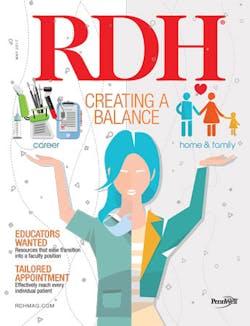The broad definition: Sharpen your dental hygiene diagnostic skills after reviewing ADHA standards
By JoAnn Gurenlian, RDH, PhD
I recently visited the faculty and students of the Universitas Gadjah Mada in Indonesia where I was asked to present several lectures. One of my presentations focused on the dental hygiene process of care and dental hygiene diagnosis. I presented the current ADHA Standards for Clinical Dental Hygiene Practice, which were revised in 2016. They can be accessed at adha.org.
For those of you who are not familiar with the standards, this document represents a framework for practice to ensure that each dental hygienist is responsible for the quality of care that is provided to each patient. “These standards promote the knowledge, values, practices, and behaviors that support and enhance oral health with the ultimate goal of improving overall health,” the document notes. The standards are meant to be used in the various professional roles of dental hygienists “to facilitate the implementation of collaborative, patient-centered care in interprofessional teams of health professionals.”1
The standards focus on six aspects of the dental hygiene process of care. These include assessment, dental hygiene diagnosis, planning, implementation, evaluation, and documentation. All components are interrelated and provide a structure for clinical practice that allows for comprehensive care.
Perhaps the most misunderstood standard of the dental hygiene process of care is the one that relates to the dental hygiene diagnosis. The dental hygiene diagnosis (DHDx) refers to the “identification of an individual’s health behaviors, attitudes, and oral health care needs for which a dental hygienist is educationally qualified and licensed to provide.”1 It is the DHDx that forms the basis for the dental hygiene treatment plan. One cannot formulate a treatment plan without a diagnosis. Determining a DHDx requires critical thinking and analysis of the assessment findings. The standards recognize that dental hygienists may identify multiple dental hygiene diagnoses for an individual patient.
The steps involved in the DHDx as stated in the standards are outlined below.
- Analyze and interpret all assessment data
- Formulate the dental hygiene diagnosis or diagnoses
- Communicate the dental hygiene diagnosis with patients or clients
- Determine patient needs that can be improved through the delivery of dental hygiene care
- Identify referrals needed within dentistry and other health care disciplines based on dental hygiene diagnoses1
What confuses most colleagues is that they are often told they cannot diagnose or they cannot perform a dental diagnosis. There is a difference in upholding clinical practice standards for providing comprehensive patient-centered care and political posturing. Diagnosis is an intellectual decision-making process that identifies a patient condition. It is not a political turf battle. Health-care providers don’t own diagnostic terms.
That large gaping hole in the occlusal surface of the tooth is caries. Physicians, nurses, dentists, dental hygienists, and even some non-health care providers recognize caries. What we do to manage that condition depends on our scope of practice. In dental hygiene, our focus is prevention.
Within our scope of practice, using caries as an example, we can conduct caries risk assessments, provide fluoride treatments and fluoride varnish, provide patient education and nutrition counseling, apply sealants, and in some states, apply interim therapeutic restorations. Dentists may choose to perform these functions, but their focus tends to be on restorative treatment. Physicians and nurses are known for providing fluoride varnish treatment to children. We all use the same diagnostic term - caries.
In some cases, dental hygienists limit themselves to two diagnostic terms - gingivitis and periodontitis. There are a host of other terms to consider that allow the dental hygienist to provide comprehensive care. Swigart and Gurenlian provide a dental hygiene diagnosis operatory chart model that offers examples of other dental hygiene diagnostic terms that could be used to formulate DHDx for patients.2 Consider options such as knowledge deficit, patient anxiety, potential for emergency, potential for injury, oral infection, xerostomia, and general health conditions.
As you think about implementing the Standards for Clinical Dental Hygiene Practice, don’t shy away from the DHDx. Rather, explore the opportunity to learn more and challenge yourself to improve your diagnostic skills. Document your DHDx for each patient and link your diagnoses to your treatment plan. Without a DHDx, how do you know your plan for patient care is complete and appropriate? RDH
JOANN R. GURENLIAN, RDH, PhD, is president of Gurenlian & Associates, and provides consulting services and continuing education programs to health-care providers. She is a professor and dental hygiene graduate program director at Idaho State University, and past president of the International Federation of Dental Hygienists.
References
1. American Dental Hygienists’ Association. Standards for Clinical Dental Hygiene Practice. 2016. American Dental Hygienists’ Association. Chicago, Illinois. Available at: www.adha.org. Accessed March 8, 2017.
2. Swigart DJ, Gurenlian JR. Implementing dental hygiene diagnosis into practice. Dimensions of Dental Hygiene. 2015;13(9):56-59. http://www.dimensionsofdentalhygiene.com/2015/09_September/Features/Implementing_Dental_Hygiene_Diagnosis_into_Practice.aspx.
